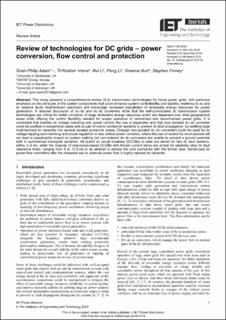| dc.contributor.author | Adam, Grain Philip | |
| dc.contributor.author | Vrana, Til Kristian | |
| dc.contributor.author | Li, Rui | |
| dc.contributor.author | Li, Peng | |
| dc.contributor.author | Burt, Graeme M. | |
| dc.contributor.author | Finney, Stephen Jon | |
| dc.date.accessioned | 2020-08-11T12:43:08Z | |
| dc.date.available | 2020-08-11T12:43:08Z | |
| dc.date.created | 2019-04-08T13:51:04Z | |
| dc.date.issued | 2019 | |
| dc.identifier.citation | IET Power Electronics. 2019, 12 (8), 1851-1867. | en_US |
| dc.identifier.issn | 1755-4535 | |
| dc.identifier.uri | https://hdl.handle.net/11250/2671504 | |
| dc.description.abstract | This study presents a comprehensive review of dc transmission technologies for future power grids, with particular emphasis on the attributes of the system components that could enhance system controllability and stability, resiliency to ac and dc network faults (fault-tolerant operation) and encourage increased exploitation of renewable energy resources for power generation. A detailed discussion of ac–dc and dc–dc converters show that the self-commutated dc transmission system technologies are critical for better utilisation of large renewable energy resources which are dispersed over wide geographical areas while offering the control flexibility needed for proper operation of centralised and decentralised power grids. It is concluded that besides dc voltage matching and power control, the use of expensive and high loss isolated dc–dc converter could be justified in exceptional cases and as part of overall protection systems to prevent dc fault propagation, by splitting large multi-terminal dc networks into several isolated protection zones. Cheaper non-isolated dc–dc converters could be used for dc voltage tapping and matching and power regulation in less critical power corridors, where the loss of control for short periods will not lead to catastrophic impact on system stability (all non-isolated dc–dc converters are unable to prevent a ground potential shift in symmetrical monopole systems). All hybrid dc circuit breakers (DCCBs) to date are aimed for fast dc fault isolation, within 3–5 ms, while the majority of resonance-based DCCBs with forced current zeros are aimed for relatively slow dc fault clearance times, ranging from 8 to 12.5 ms in an attempt to reduce the cost compared with the former type. Series-type dc power flow controllers offer the cheapest way to optimise power flow in highly meshed dc networks. | en_US |
| dc.description.abstract | Review of technologies for DC grids – power conversion, flow control and protection | en_US |
| dc.language.iso | eng | en_US |
| dc.publisher | IET | en_US |
| dc.rights | Attribution-NonCommercial-NoDerivatives 4.0 Internasjonal | * |
| dc.rights.uri | http://creativecommons.org/licenses/by-nc-nd/4.0/deed.no | * |
| dc.title | Review of technologies for DC grids – power conversion, flow control and protection | en_US |
| dc.type | Peer reviewed | en_US |
| dc.type | Journal article | en_US |
| dc.description.version | acceptedVersion | en_US |
| dc.rights.holder | IET | en_US |
| dc.source.pagenumber | 1851-1867 | en_US |
| dc.source.volume | 12 | en_US |
| dc.source.journal | IET Power Electronics | en_US |
| dc.source.issue | 8 | en_US |
| dc.identifier.doi | 10.1049/iet-pel.2018.5719 | |
| dc.identifier.cristin | 1690858 | |
| cristin.unitcode | 7548,50,0,0 | |
| cristin.unitname | Energisystemer | |
| cristin.ispublished | true | |
| cristin.fulltext | postprint | |
| cristin.qualitycode | 1 | |

